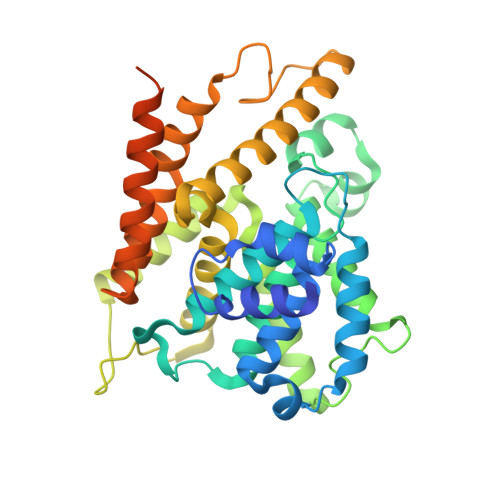Discovery and Structural Optimization of Toddacoumalone Derivatives as Novel PDE4 Inhibitors for the Topical Treatment of Psoriasis.
Song, Z., Huang, Y.Y., Hou, K.Q., Liu, L., Zhou, F., Huang, Y., Wan, G., Luo, H.B., Xiong, X.F.(2022) J Med Chem 65: 4238-4254
- PubMed: 35188767
- DOI: https://doi.org/10.1021/acs.jmedchem.1c02058
- Primary Citation of Related Structures:
7W4X, 7W4Y - PubMed Abstract:
Psoriasis is a common immune-mediated skin disorder manifesting in abnormal skin plaques, and phosphodiesterase 4 (PDE4) is an effective target for the treatment of inflammatory diseases such as psoriasis. Toddacoumalone is a natural PDE4 inhibitor with moderate potency and imperfect drug-like properties. To discover novel and potent PDE4 inhibitors with considerable druggability, a series of toddacoumalone derivatives were designed and synthesized, leading to the compound (2 R ,4 S )-6-ethyl-2-(2-hydroxyethyl)-2,8-dimethyl-4-(2-methylprop-1-en-1-yl)-2,3,4,6-tetrahydro-5 H -pyrano[3,2- c ][1,8]naphthyridin-5-one ( 33a ) with high inhibitory potency (IC 50 = 3.1 nM), satisfactory selectivity, favorable skin permeability, and a well-characterized binding mechanism. Encouragingly, topical administration of 33a exhibited remarkable therapeutic effects in an imiquimod-induced psoriasis mouse model.
Organizational Affiliation:
National-Local Joint Engineering Laboratory of Druggability and New Drugs Evaluation, Guangdong Province Engineering Laboratory for Druggability and New Drug Evaluation, School of Pharmaceutical Sciences, Sun Yat-sen University, 510006 Guangzhou, P. R. China.

















